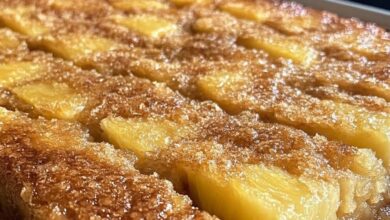Pound Cake – A Timeless Classic That Never Fails

Pound Cake – A Timeless Classic That Never Fails
Introduction: The Sweet Simplicity of Pound Cake
There’s something profoundly comforting about a thick slice of Pound Cake—its buttery aroma filling the kitchen, its golden crust cracking ever so slightly as it cools on the counter. This beloved dessert, with roots tracing back to 18th-century Europe, has stood the test of time for one simple reason: it’s pure, uncomplicated perfection.
Originally, Pound Cake was named for its formula—one pound each of butter, sugar, eggs, and flour. This straightforward ratio gave bakers a reliable, rich cake that could feed large families and gatherings. Over centuries, this dessert has evolved with countless variations, from the Classic Southern Pound Cake served at church potlucks to modern favorites like Lemon Pound Cake made famous by Starbucks.
Today, Pound Cake remains a staple in homes and bakeries alike. Whether enjoyed plain, glazed, or topped with fresh berries and whipped cream, it’s a dessert that bridges generations. It’s not just a cake—it’s a memory baked into every bite.
Why This Recipe Works
The magic of Pound Cake lies in its simplicity and balance. Every ingredient serves a clear purpose, creating a cake that’s dense yet tender, sweet yet not cloying, buttery yet never greasy.
Here’s why this recipe works so beautifully:
Butter as the Foundation – Butter is the backbone of any good Pound Cake. When creamed properly with sugar, it traps air, giving the cake structure and that melt-in-your-mouth texture.
The Right Sugar Ratio – Too little sugar and your cake will be dry; too much, and it will sink. Sticking to a classic pound ratio or adjusting slightly for taste ensures perfect sweetness.
Eggs for Richness and Stability – Eggs act as both a binder and leavening agent. They provide moisture, help the cake rise slightly, and contribute to that fine, tight crumb.
Flour for Structure – Cake flour gives a softer texture, while all-purpose flour delivers a heartier crumb. The balance ensures your Pound Cake holds up beautifully when sliced.
Flavor Enhancers – A touch of vanilla, lemon zest, or sour cream elevates the flavor without overpowering the classic buttery essence.
Low and Slow Baking – The secret to a perfect Pound Cake is patience. Baking it at a moderate temperature allows the inside to cook through before the crust gets too dark.
This combination of technique and precision creates a cake that’s moist, dense, and irresistibly aromatic—a dessert that feels homemade even in its most elegant form.
What You’ll Need for This Recipe
To make the ultimate Pound Cake, you’ll need just a few simple pantry staples, plus a little love and care. These ingredients work together to produce the perfect texture and flavor every time.
Ingredients:
1 cup (2 sticks) unsalted butter, softened
2 cups granulated sugar
4 large eggs, room temperature
3 cups all-purpose flour
1 cup milk (or buttermilk for extra tenderness)
1 teaspoon pure vanilla extract
1 teaspoon baking powder (optional, for a lighter rise)
A pinch of salt
Optional Add-ins for Flavor Variations:
Lemon zest and glaze – for a Lemon Pound Cake twist.
Sour cream – as in Paula Deen’s Sour Cream Pound Cake, adds moisture and depth.
Cocoa swirl – for a Marble Pound Cake that’s both pretty and delicious.
Good vanilla extract or almond essence – like Ina Garten’s Perfect Pound Cake for an elegant flavor.
Equipment:
A hand or stand mixer
9×5-inch loaf pan (or bundt pan for a more traditional shape)
Mixing bowls
Rubber spatula
Cooling rack
With just these basics, you’re ready to make a cake that’s tender, aromatic, and guaranteed to please every guest.
How to Make This Pound Cake Recipe
Making a perfect Pound Cake is as much about technique as it is about ingredients. Follow these simple steps for bakery-quality results every time.
Step 1: Prep Your Pan and Ingredients
Preheat your oven to 325°F (163°C). Grease your loaf or bundt pan generously with butter, then dust lightly with flour or line with parchment paper. Ensure all ingredients are at room temperature—this helps them blend seamlessly and create that perfect texture.
Step 2: Cream the Butter and Sugar
In a large mixing bowl, beat the butter and sugar together until pale and fluffy—about 3 to 5 minutes. This step incorporates air and gives the Pound Cake its light yet dense crumb. Don’t rush this process; it’s key to your cake’s success.
Step 3: Add the Eggs
Add eggs one at a time, beating well after each addition. This prevents curdling and ensures even texture. You’ll notice the batter becoming rich and glossy—a sign that it’s coming together beautifully.
Step 4: Mix in the Dry Ingredients
In a separate bowl, whisk together the flour, baking powder (if using), and salt. Gradually add the dry ingredients to the wet mixture, alternating with milk. Begin and end with flour for best consistency.
Step 5: Add Flavorings
Stir in vanilla extract or your preferred flavorings like lemon zest, almond extract, or even cocoa. At this stage, your kitchen will already start to smell divine.
Step 6: Bake the Cake
Pour the batter evenly into your prepared pan. Bake for 60–75 minutes, depending on your oven and pan size. The Pound Cake is done when a toothpick inserted in the center comes out clean.
Step 7: Cool and Serve
Let the cake cool in the pan for 10 minutes before transferring it to a wire rack. This prevents breaking and keeps the bottom from getting soggy. Once cooled, slice and enjoy with your favorite toppings—or just as it is, in all its buttery glory.
Tips + Tricks & More for Recipe Success
Even though Pound Cake is simple, there are a few insider tips that will take your baking game from good to unforgettable.
Use room-temperature ingredients – Cold butter or eggs can cause curdling and uneven mixing.
Don’t overmix the batter – Once the flour is in, mix just until combined. Overmixing toughens the crumb.
Measure accurately – For consistent results, use measuring cups or a kitchen scale.
Rotate halfway through baking – This ensures even cooking, especially in older ovens.
Use good-quality butter – The butter’s flavor is the star of Pound Cake, so choose the best you can.
Let it rest before slicing – A warm cake may crumble; cooling fully allows it to firm up perfectly.
Store properly – Wrap tightly in plastic or store in an airtight container. Pound Cake keeps beautifully for several days and freezes well for up to 3 months.
Bonus tip: To elevate presentation, dust with powdered sugar, drizzle with glaze, or top with berries and whipped cream for that café-worthy finish.
How to Serve Pound Cake
Pound Cake is one of those rare desserts that’s perfect any time of day. You can serve it warm, chilled, or even toasted—yes, toasted! A slice lightly grilled with butter tastes heavenly at breakfast with coffee or tea.
For gatherings, slice the Pound Cake thickly and serve with fruit compote, vanilla ice cream, or homemade whipped cream. It’s elegant enough for holidays yet simple enough for everyday indulgence.
Serving Suggestions
Here are a few delightful ways to enjoy your Pound Cake:
Classic Style: Serve it plain with a cup of tea or coffee.
Fresh & Fruity: Top with macerated strawberries and whipped cream for a shortcake-style dessert.
Café-Inspired: Try a lemon glaze for that iconic Lemon Pound Cake experience.
Chocolate Twist: Swirl in cocoa for a marble design and drizzle with ganache.
Southern Comfort: Add a dollop of butter pecan ice cream for a rich, indulgent finish.
Brunch Favorite: Toast slices and spread with cream cheese or jam.
Every variation proves why Pound Cake remains a beloved classic—it adapts beautifully to every occasion.
Time
Prep Time: 20 minutes
Cook Time: 60–75 minutes
Cooling Time: 30 minutes
Total Time: About 2 hours
Servings: 10–12 slices
That means in just a couple of hours, you can have a bakery-style Pound Cake cooling on your counter, ready to serve with your favorite toppings or enjoyed plain with a warm drink.
Final Thoughts on the Timeless Pound Cake
Few desserts carry the same charm, versatility, and history as Pound Cake. Its buttery aroma and tender crumb evoke comfort and nostalgia in every bite. Whether you’re baking a Classic Southern Pound Cake, a Lemon Pound Cake, or the ever-popular Marble Pound Cake, the beauty of this dessert lies in its adaptability and simplicity.
It’s more than a recipe—it’s a tradition. Passed down through families, adapted by chefs, and perfected by home bakers, Pound Cake proves that sometimes, the simplest things in life truly are the best.



